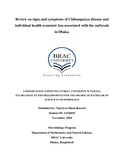Review on signs and symptoms of Chikungunya disease and individual health economic loss associated with the outbreak in Dhaka

View/
Date
2018-11Publisher
BRAC UniversityAuthor
Rozario, Marriyen ShatuMetadata
Show full item recordAbstract
Over the most recent couple of decades, chikungunya infection transmitted by Aedes spp mosquitoes has re-emerged in Africa, southern and southeastern Asia, and the Indian Ocean Islands as the reason for substantial flare-ups of human ailment. The sickness is described by the indications of fever, cerebral pain, myalgia, rash, and both intense and relentless arthralgia. The infection is endemic to tropical districts. Chikungunya is a viral disease transmitted by mainly Aedes aegypti and Aedes albopictus mosquitoes. In 2017, Chikungunya virus was introduced into the Dhaka city of Bangladesh and triggered a massive outbreak which affected millions of lives and forced upon significant damages in socioeconomic factors. Since the disease appeared quite recently in this region and this is the first time such a widespread transmission occurred, there is a lack of adequate data to assess the viral burden in the population and the effectiveness of laboratory procedures that can be implemented in resource limited countries like Bangladesh. This paper centers around the re-rise of this illness, the study of disease transmission, world point of view, Bangladesh viewpoint, outbreak in Dhaka city and economic analysis of Chikungunya disease.
